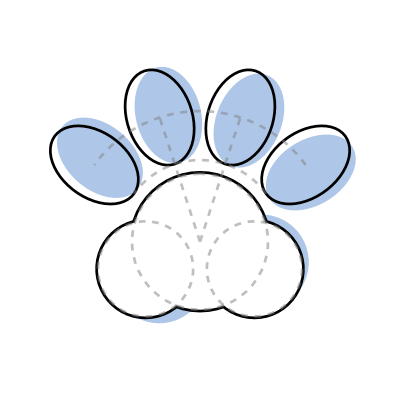Diagramatics

Diagramatics is a JavaScript/TypeScript library that makes it easy to create interactive diagrams, especially math and physics diagrams. It provides a simple high-level API for creating and manipulating diagram elements and interactive controls.
Examples
let porigin = V2(0,0);
let ppulley = V2(5,10);
let pulley_radius = 0.5;
let pulley = circle(pulley_radius).position(ppulley)
.fill('lightgrey').stroke('grey').strokewidth(2);
let topy = 10.8;
let ceiling = rectangle(10.5, 0.1).move_origin('bottom-left').position(V2(-2.5,topy))
.fill('lightgray').stroke('none');
let pL = geometry.circle_tangent_point_from_point(porigin, pulley)[1];
let pR = pulley.origin.add(V2(pulley_radius, 0));
let trackline = line(porigin, pL).strokedasharray([5]).stroke('gray');
let track = trackline.apply(mod.slicepath(0.15, 0.75, 100));
let phand0 = trackline.parametric_point(0.8)
let vhand = porigin.sub(pL).normalize();
let pBox0 = pR.sub(V2(0,1).scale(10));
let x0 = phand0.sub(pL).length();
int.draw_function = (inp) => {
let phand = inp['phand'];
let x = phand.sub(pL).length();
let dx = x - x0;
let pBox = pBox0.add(V2(0, dx));
let box = square(2).move_origin('bottom-center').position(pBox)
.fill('lightblue').stroke('none');
let ropes = diagram_combine(
line(pL, phand),
line(pR, box.get_anchor('top-center')),
line(pulley.origin, V2(pulley.origin.x, topy)),
);
let annotations = diagram_combine(
annotation.length(phand, phand0, 'x', -0.5, 0.2),
annotation.length(pBox0, pBox, 'x', 1.2, 0.2, 1.5),
).stroke('gray').textfill('black');
let vectors = diagram_combine(
annotation.vector(V2(0,-1).scale(1.4), 'W', V2(-0.5,0.0), 0.1)
.position(box.get_anchor('center-center')),
annotation.vector(vhand.scale(1.4), 'F = W', V2(-0.3,0.3), 0.1)
.position(phand).textanchor('end'),
).fill('black').fontsize(13);
draw(
trackline, ropes,
pulley, box, ceiling,
annotations, vectors,
);
}
int.locator('phand', track.parametric_point(0.8), 0.5, 'blue', track);
int.draw();
int.locator_draw();
let x0 = 50;
let amplitude = 25;
let omega = 1;
int.draw_function = (inp) => {
let t = inp['t'];
let x = x0 + amplitude * Math.cos(omega * t);
let wall = line(V2(0,0), V2(0,20)).strokewidth(2);
let floor = line(V2(0,0), V2(100,0)).strokewidth(2);
let box = square(20).position(V2(x,10))
.fill('lightblue').stroke('none');
let p1 = wall.get_anchor('center-right');
let p2 = box.get_anchor('center-left');
let spring = mechanics.spring(p1,p2, 2, 10, 1.2);
draw(box, wall, floor, spring)
}
let period = 2*Math.PI/omega;
int.slider('t', 0, 2*period, period/4, 0.1, 2);
int.draw();
let pip_positions = {
1 : [V2(0,0)],
2 : [V2(-1,-1), V2(1,1)],
3 : [V2(-1,-1), V2(0,0), V2(1,1)],
4 : [V2(-1,-1), V2(1,-1), V2(-1,1), V2(1,1)],
5 : [V2(-1,-1), V2(1,-1), V2(0,0), V2(-1,1), V2(1,1)],
6 : [V2(-1,-1), V2(1,-1), V2(-1,0), V2(1,0), V2(-1,1), V2(1,1)],
}
let generate_dice_pips = (n) => {
let positions = pip_positions[n];
let pips = positions.map((p) => regular_polygon(10,0.25).position(p));
return diagram_combine(...pips).fill('black').stroke('none');
}
let generate_dice = (n) => {
let outline = square(4)
.apply(mod.round_corner(0.5, undefined, 4))
.fill('white').stroke('black').strokewidth(2);
let pips = generate_dice_pips(n);
return diagram_combine(outline, pips);
}
const dice_diagram = [1,2,3,4,5,6].map((n) => generate_dice(n).mut());
function randint(min, max) {
return Math.floor(Math.random() * (max - min + 1)) + min;
}
let dicevalue = new Array(20*2).fill(1);
let bincount = new Array(12+1).fill(1);
let datanames = range_inc(1,12).map(String);
function reroll() {
for (let i = 0; i < dicevalue.length; i++) dicevalue[i] = randint(1,6);
}
function countbin(n){
bincount.fill(0);
for (let i = 0; i < n; i++) {
let val = dicevalue[2*i] + dicevalue[2*i+1];
bincount[val] += 1;
}
}
// ============================= diagram
let subdiagram1 = rectangle(30,30);
let subdiagram2 = rectangle(40,30).move_origin('top-left').position(subdiagram1.get_anchor('top-right'));
let bbox2 = subdiagram2.bounding_box();
let diagram_bg = subdiagram1.combine(subdiagram2).stroke('none');
let baropt = {
yrange : [0,10.1],
bbox : [bbox2[0].add(V2(2,6)), bbox2[1].sub(V2(2,3))],
ticksize: 0.5,
}
let xax = bar.xaxes(datanames, baropt);
let yax = bar.yaxes(bincount.slice(1), baropt);
let xlabel = text('value').move_origin_text('top-center')
.position(xax.get_anchor('bottom-center')).translate(V2(0,-3));
let ylabel = text('# of occurrence').move_origin_text('bottom-center')
.position(yax.get_anchor('center-left')).translate(V2(-1.5,0))
.textangle(to_radian(-90));
let ddots_ = text('⋯').position(subdiagram1.get_anchor('bottom-right'))
.translate(V2(-5.5,8))
let bgrect = rectangle(6,13).apply(mod.round_corner(1, undefined, 4))
.fill('lightblue').stroke('none').mut();
int.draw_function = (inp) => {
default_textdata["font-scale"] = "0.11";
let n = inp['n'];
countbin(n);
// diagram1
let dicepairlist = range(0,Math.min(n,7)).map((i) => {
let vtop = dicevalue[2*i];
let vbot = dicevalue[2*i+1];
let vsum = vtop + vbot;
let dtop = dice_diagram[vtop-1].copy();
let dbot = dice_diagram[vbot-1].copy();
let lsum = text(vsum);
let pair = distribute_vertical_and_align([lsum, dtop, dbot], 1)
let bg = bgrect.copy().position(pair.origin).translate(V2(0,-4.5));
return bg.combine(pair).mut();
});
let dice = distribute_grid_row(dicepairlist, 4, 0.5, 0.5).flatten()
.move_origin('top-left')
.position(subdiagram1.get_anchor('top-left').add(V2(2,-2)));
let ddots = n > 7 ? ddots_ : empty(V2(0,0));
// diagram2
let bars = bar.plot(bincount.slice(1), baropt).fill('lightblue').stroke('none');
// draw
draw(
diagram_bg, dice,
ddots,
bars, xax, yax, xlabel, ylabel,
);
reset_default_styles();
}
int.slider('n', 1, 20, 10, 1);
reroll();
int.draw();
let btn = document.getElementById("roll_double");
btn.onclick = () => {
reroll();
int.draw();
}